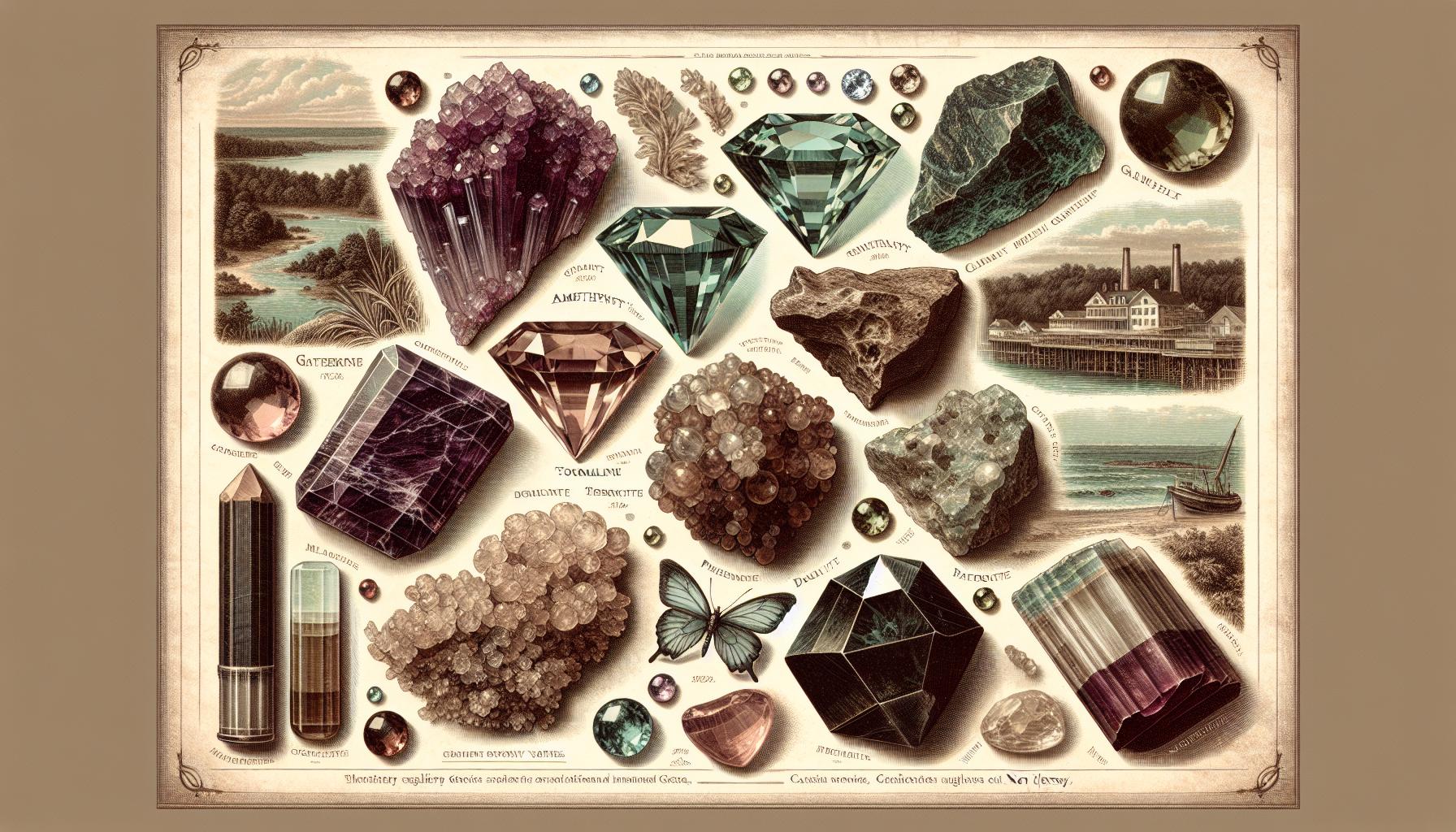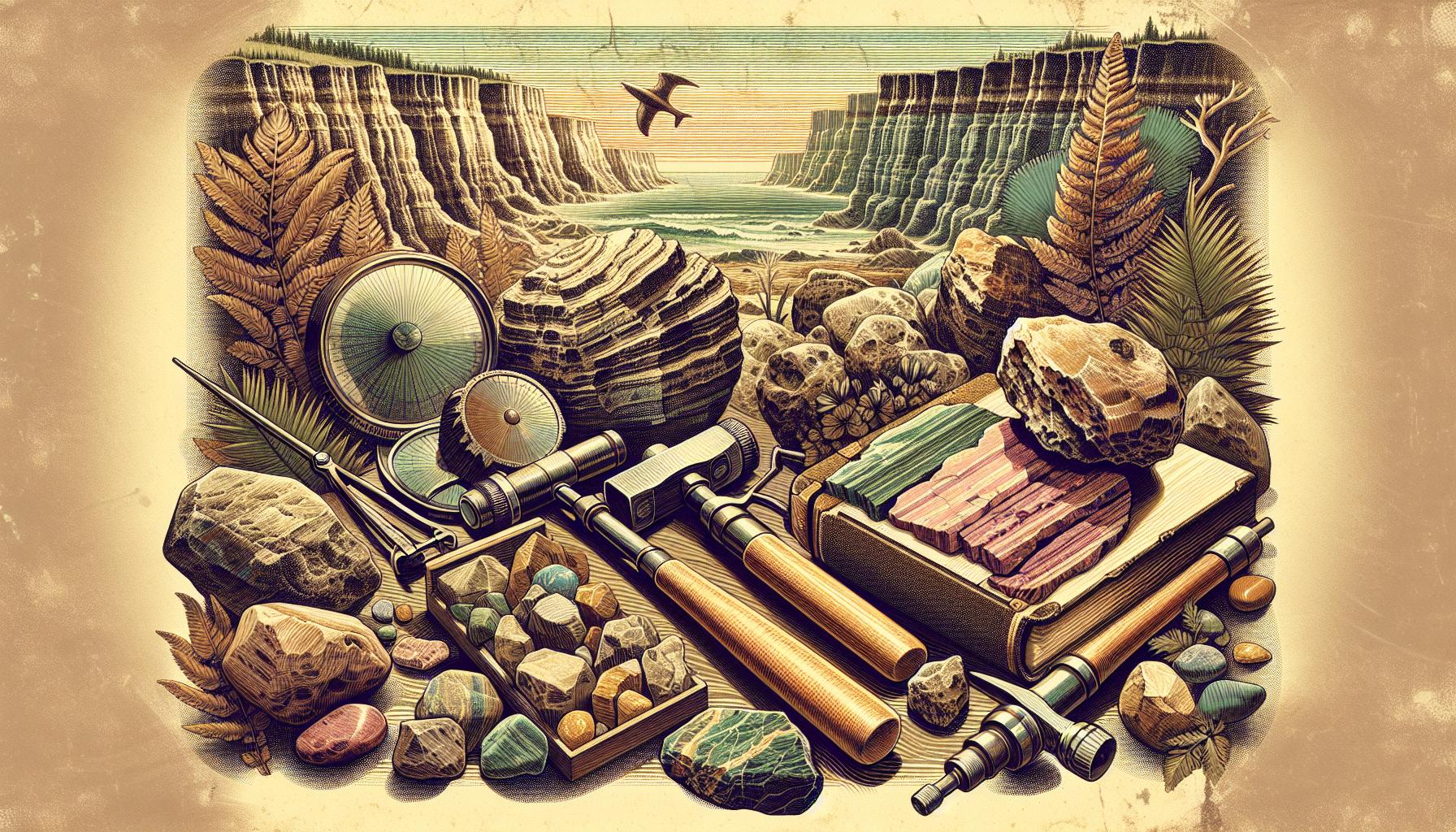Ready to uncover the hidden gems of the Garden State?
New Jersey might not be the first place you think of for rockhounding, but it’s a treasure trove for enthusiasts. From the beaches to the mountains, you’ll find a diverse array of minerals and fossils just waiting to be discovered.
Whether you’re a seasoned rockhound or just starting, New Jersey’s unique geology offers an exciting adventure. You’ll be amazed at what you can find, from sparkling quartz to ancient fossils.
Gear up for a journey to some of the best spots for rockhounding in New Jersey.
In New Jersey, rockhounds can explore diverse sites like the Franklin Mine for fluorescent minerals, the Cape May Peninsula for quartz crystals, the Watchung Mountains for prehistoric fossils, and Big Brook Park for shark teeth. Adherence to property rights and regulations is key for a successful experience.
New Jersey Rockhounding Locations
New Jersey’s landscape is a treasure trove for rockhounds. Each locale offers a distinct array of minerals and fossils that tempt enthusiasts from near and far. Your rockhounding journey in the Garden State can lead to more than just a walk on the beach; it can be a step back into Earth’s deep geological past.
One location not to be overlooked is the Franklin Mine in Sussex County. This world-famous site is especially known for its fluorescent minerals and rare species of zinc ore. When you’re planning your visit, bring a UV light to experience the truly mesmerizing glow of the rocks found here.
In the Southern reaches, the Cape May Peninsula provides a more subdued rockhounding experience, but it’s no less rewarding. Along the shores, you may find petrified wood or Cape May diamonds – quartz crystals that, when polished, bear a striking resemblance to real diamonds.
Here’s a quick list of some prime spots:
- Franklin Mine: Fluorescent minerals
- Cape May Peninsula: Cape May diamonds, petrified wood
- The Watchung Mountains: Prehistoric fossils
- Big Brook Park: Shark teeth and other marine fossils
The Watchung Mountains are a prime destination for fossil enthusiasts, offering sedimentary layers full of prehistoric tales. Similarly, Big Brook Park is known for its abundance of marine fossils, such as shark teeth, that date back millions of years. Remember to gear up with a sturdy hammer, chisels, and safety glasses before heading out to these fossil-rich sites.
While you’re exploring these locations, keep an eye out for the state’s official mineral, Franklinite, and its official gemstone, Garnet. They’re not only beautiful but also carry with them the story of New Jersey’s robust geological heritage.
Each location comes with its rules and regulations, so be sure to check access rights and acquire any necessary permits. Furthermore, always adhere to the rockhounder’s credo: “Take only memories, leave only footprints.” By doing so, you’ll ensure that these sites remain pristine for future generations of enthusiasts.
What Gemstones are Found in New Jersey?

When you’re delving into the diverse geology of New Jersey, you’ll discover that it’s a treasure trove for gemstone enthusiasts. Aside from the official state gemstone, garnet, there are a variety of other coveted gemstones native to this region.
Quartz is arguably the most abundant gemstone you can find in New Jersey. This mineral comes in several varieties, including the sought-after amethyst. With its purple hue, amethyst is a favorite among rockhounds. Explore the areas around the Watchung Mountains, and you might be lucky enough to stumble upon this gem.
Tourmaline is another gemstone variety that beckons in New Jersey. Known for its wide spectrum of colors, mining for this mineral can yield surprising and vibrant results. Look for tourmaline in the Franklin Mine, where you may also find other mineral rarities.
- Quartz (including Amethyst)
- Tourmaline
- Garnet
Moving on, the garnet group of minerals, including almandine and grossular varieties, are commonly found. Almandine, recognized by its deep red color, can be found embedded in the matrix of the host rock. Grossular garnets, which can range from colorless to a rich green, are more rare but can be discovered in specific sites.
For those interested in a challenge, Prehnite and Datolite are two lesser-known gemstones that can be unearthed in the Garden State. Prehnite, with its delicate green hues, is often found in the basalt deposits of the state. Datolite, while more obscure, presents itself in various colors and is known for its glassy luster. Both of these gemstones require a keen eye and some knowledge of where to search, adding an exciting layer to your rockhounding experience.
Before you set out on your quest for these gemstones, always remember to verify your access to potential sites and, if necessary, secure permits. Happy hunting and may your efforts uncover the hidden gems of New Jersey.
What Sedimentary Rocks You Can Find in New Jersey?

When you’re exploring New Jersey’s rockhounding scene, you’ll not only encounter a variety of gemstones but also an array of sedimentary rocks. Sedimentary layers in New Jersey’s geological makeup reveal ancient environmental conditions and offer a window into the distant past.
The Kittatinny Valley and its surrounding areas are prime spots for discovering sedimentary formations. Here you might find:
- Shale
- Sandstone
- Conglomerate
Shale, typically grey to black, is often rich with organic material and can sometimes bear fossil imprints of extinct lifeforms. In contrast, the sandstone in New Jersey ranges in color, offering shades like tan, red, and brown. This stone is particularly sought after for its aesthetic qualities and construction value.
Conglomerate rocks, recognized by their varied and sizable inclusions of rounded clasts, present a fascinating find. These natural mosaics hint at a past where waterways transported and deposited different rock types over time.
In the central parts of New Jersey, collectors find sedimentary sequences reaching back to the Cretaceous Period. Here, you might unearth:
- Limestone
- Marl
Limestone, mainly composed of skeletal fragments of marine organisms, has significant commercial and educational value. It’s widely used in industry and architecture. Marl, which is a combination of clay and calcium carbonate, offers insight into the marine ecosystems of the Cretaceous.
Remember, while rockhounding, always carry a field guide that helps you identify the sedimentary rocks you encounter. Additionally, make sure you’re aware of the ownership of the land and have the appropriate permissions to collect rocks.
Ensure not to disrupt the natural habitat, as every rock and fossil plays a part in delineating New Jersey’s rich geological history. With respectful exploration, you’ll enjoy the thrill of discovery and the beauty of New Jersey’s sedimentary offerings.
What Metamorphic Rocks are found in New Jersey?
As you delve into New Jersey’s geologic treasure trove, you’ll find that it isn’t just sedimentary rocks that capture the attention of rockhounds. The state’s geological diversity extends to intriguing metamorphic rocks with unique textures and complex histories. The northwestern parts of New Jersey, particularly the Highlands region, are renowned for their abundance of metamorphic rocks.
Gneiss, a banded and foliated rock formed under high-temperature and high-pressure conditions, is among the most significant metamorphic rocks you’ll come across in this area. Its alternating bands of light and dark minerals are not just visually striking but also tell a story of intense geological processes. These rocks often contain eye-catching minerals such as garnet and magnetite, which can be a bonus for your collection.
In addition to gneiss, the Highlands are also home to schist, which is characterized by its platy minerals and potential to contain precious gems like garnet and staurolite. This area has undergone several episodes of mountain-building, which means there’s a vast range of schist varieties each with their own mineralogical makeup. Collectors with a keen eye may also find amphibolite, a dark, coarse-grained metamorphic rock rich in amphibole minerals.
While exploring these regions:
- Always check for accessibility and ensure you’re not venturing onto private property without permission.
- Wear proper safety gear.
- Take note of the weather conditions, as some areas can be treacherous in inclement weather.
Here are important facts to remember when searching for metamorphic rocks in New Jersey:
- Gneiss and schist dominate the Highlands region.
- Look for garnet and staurolite as indicators of schist.
- Amphibolite presence suggests a high degree of metamorphism.
Keep in mind that these rocks aren’t just remarkable for their appearance; they’re also a record of New Jersey’s dynamic geological evolution. Whether you’re a seasoned rockhound or a curious novice, a field guide to metamorphic rocks can be an invaluable tool to help you identify and appreciate the complexities of these ancient stones. Remember, each piece you find is a fragment of the state’s enduring geological narrative.
What Igneous Rocks can You Find in New Jersey?
When you’re rockhounding in New Jersey, be on the lookout for the state’s impressive variety of igneous rocks. These rocks form from the cooling and solidification of molten material, providing a unique glimpse into the fiery processes beneath the Earth’s surface. New Jersey’s igneous rocks are primarily associated with ancient volcanic activity and magma intrusions.
Basalt is one of the most prevalent igneous rocks in the region, particularly found in the Palisades Sill along the Hudson River. Here, the striking columnar jointed basalt cliffs tower impressively, offering not just a picturesque view but a veritable feast for avid rockhounds.
Another fascinating find is diabase, a coarse-grained rock that’s part of the Watchung Mountains. These mountains are remnants of Triassic-Jurassic period lava flows and are now prime spots for finding high-quality diabase specimens.
You might also discover pegmatite, a very coarse-grained intrusive igneous rock, often with sizable crystals. Pegmatite pockets can contain valuable minerals, including feldspar, quartz, and in rarer instances, gem-quality crystals such as tourmaline and aquamarine. Franklin, known for its fluorescent minerals, and Ogdensburg are renowned locales where you can encounter these intriguing rocks.
Below is a quick list of igneous rocks you’re likely to encounter in New Jersey:
- Basalt
- Diabase
- Pegmatite
For the best experience and success in finding these rocks, research specific locations beforehand. Pay close attention to open public sites versus restricted private property. Always adhere to local regulations and seek permission when necessary. Remember, the act of discovering these natural treasures is a privilege that requires respect for the land and its long-standing geological history.
Happy hunting, and don’t forget your field guide to help you identify the plethora of igneous rocks scattered throughout New Jersey’s diverse geologic landscape. The thrill of finding your own piece of the Earth’s deep-rooted fiery past is an unparalleled experience. Keep your eyes peeled, and you may just stumble upon some of the Garden State’s hidden igneous gems.
Panning for Gold in New Jersey
While New Jersey may not come to mind when you think of gold panning, it’s a little-known fact that there are indeed places in the Garden State where you can try your luck. You might be surprised to learn that the Highlands Region of Northern New Jersey harbors gold. The geologic conditions here provide a setting where gold deposition might occur.
When you’re aiming to pan for gold in New Jersey, there are specific streams known to have fine gold deposits. Your best bet is to explore the areas around Morris County, particularly the streams that drain the eastern part of the Franklin marble belt. This region has historically reported finds of placer gold, the flakes and nuggets you can collect from stream beds.
To get started, you’ll need a pan and a sense of adventure. Panning requires patience since gold is much denser than other materials and will settle at the bottom. Swiftly swirling water in your pan will gradually reveal heavier materials, including potential gold.
Safety and legality first: always ensure you’re not trespassing on private property, and check local regulations pertaining to mineral collection. Some streams may be protected, and unauthorized prospecting can result in hefty fines.
- Start with:
- Permission from landowners (if necessary)
- Basic equipment: gold pan, classifier, and shovel
- Knowledge of local rules
In terms of locations, the Ramapo River is a known spot for enthusiasts. Additionally, consider the areas near the Peters Mine and Edison Mine, which have histories tied to gold. The rock outcrops near these old mines sometimes release gold particles into nearby streams, making them target spots for panners.
Remember, patience is the key to success in panning for gold. The thrill of finding your first glittering speck can be an unforgettable experience, especially when you’re surrounded by New Jersey’s natural beauty. Keep refining your technique, explore cautiously, and who knows—next time you could strike it rich in the most unexpected of places.
Rocks and Minerals Found in New Jersey
Venturing into the diverse geology of New Jersey, you’ll find that the state is more than a trove of igneous rocks. New Jersey is rich in a variety of minerals and offers ample opportunities for rockhounds to expand their collections. Among these minerals, Franklinite, a zinc iron oxide mineral, is a significant find in the Franklin Mining District. This area, often revered by mineral collectors, is home to precisely the type of treasures that ignite a rockhound’s passion.
In addition to Franklinite, Willemite and Calcite shine brightly under ultraviolet light, making them popular among collectors for their fluorescent properties. These minerals are usually intermingled within the same ore bodies and can be found at the Sterling Hill Mining Museum, where you can dig for them yourself. Take note that some of the best specimens have been discovered here.
Quartz varieties, such as amethyst, smoky quartz, and clear quartz, are also present in numerous locations throughout the state. Known for their hardness and durability, quartz crystals can be excellent additions to your rock collection. Amethyst, with its alluring purple hue, can occasionally be unearthed in the northern parts of New Jersey, adding a touch of color to the more commonly found minerals.
Here’s a quick list of other minerals discovered in New Jersey that you can add to your must-find checklist:
- Magnetite
- Hematite
- Garnet
- Copper
For precise locations and strategies to locate these minerals, thorough research is your best tool. Always prepare adequately, familiarize yourself with the local geology, and seek permissions if needed. Remember, the right approach not only leads to successful finds but also ensures that these geological wonders remain preserved for generations to come.
Where Can I Find Fossils in New Jersey?
New Jersey boasts a rich paleontological history, offering ample opportunities for fossil enthusiasts to indulge in their passion. When you’re on the hunt for ancient remnants, knowing where to look is crucial. The state’s fossilized treasures date back millions of years, unveiling stories from the Cretaceous period through to the Pleistocene.
Big Brook Preserve in Monmouth County is a well-known hotspot for finding shark teeth, belemnites, and fossilized shells. As you sift through the brook’s sediments, you’ll discover marine fossils that tell tales of the time when New Jersey was submerged under a vast ocean.
In the glauconite-rich greensands of the Ramanessin Brook, you can find an array of marine fossils. These sands are leftover from an ancient sea, once teeming with life, and now yield fossils like squid-like belemnites and brachiopods.
Don’t overlook the productive site Poricy Brook which is known for its fossil shark teeth and other Cretaceous-period finds. Here’s a hint – after heavy rains, your chances of unearthing these hidden gems significantly increase. Always remember to check local regulations and obtain permissions where necessary, ensuring your fossil hunting is responsible and respectful to the environment.
| Popular Fossil Hunting Locations in New Jersey |
|---|
| Big Brook Preserve |
| Ramanessin Brook |
| Poricy Brook |
In addition to these sites, the coastal cliffs of the Atlantic Highlands may reveal fossils of sea creatures trapped in sediments for millennia. With a keen eye and a bit of patience, you might spot the imprints of ancient life that once thrived here.
Venturing through New Jersey’s fossil-rich locations, you’re not just exploring; you’re taking a step back in time. Each fossil you find contributes to the larger story of the geological history that has shaped not only New Jersey but our understanding of the Earth’s past.
New Jersey Rockhounding Laws & Regulations
When you’re planning your rockhounding trip in New Jersey, understanding the state’s laws and regulations is crucial. One of the most important things to remember is that collecting on private property without permission is illegal. Always seek permission from landowners before venturing onto their land to hunt for rocks or fossils.
In state parks and natural preserves, rockhounding activities are often restricted or prohibited to protect the environment. Check with park officials before you start your search. Many parks require a permit for collecting specimens, even for personal use. New Jersey’s Department of Environmental Protection governs these activities, and failure to comply with their rules can result in hefty fines.
- Permit Requirements: Before collecting, see if the area requires a permit.
- Area Restrictions: Some areas may have complete bans on collecting.
- Equipment Restrictions: Usage of tools might be limited to protect the natural habitats.
For areas like the famous Franklin Mining District, regulations are in place to preserve historic sites and geological features. It’s your responsibility to comply with these rules and ensure that the sites remain available for future generations of rockhounds to enjoy.
Always practice Leave No Trace principles when out in the field. This means taking out everything you bring in, respecting wildlife, staying on designated trails, and of course, leaving rocks, plants, and other natural features as you find them unless you’ve received explicit permission to collect.
Remember, rockhounding isn’t just a hobby; it’s a stewardship activity. By following the laws and regulations, you help protect New Jersey’s geological diversity. Regularly check the latest guidelines from the New Jersey Geological Survey or join a local rockhound group to stay informed on the current laws that influence your exciting pursuit.
Rockhounding Tips for Beginners in New Jersey
Gearing Up: Essential Tools for Rockhounding
Before you set out on your adventure, it’s vital to gear up with the right tools. Proper equipment not only makes your rockhounding trip more productive but also ensures that you can extract specimens safely and efficiently.
- Rock Hammer: This is an indispensable tool for chipping away at rock and extracting minerals.
- Chisel: Pair a sturdy chisel with your hammer to split rocks and reveal hidden treasures.
- Safety Goggles: Protect your eyes from flying debris when cracking rocks.
- Gloves: Durable gloves will safeguard your hands and improve grip.
- Bucket or Backpack: You’ll need something to carry your finds.
- Field Guide: Carry a field guide to help identify the minerals and fossils you encounter.
Make sure your tools are comfortable to use and suited to the terrain of New Jersey’s diverse geological landscape.
Safety Tips While Rockhounding
Rockhounding can be a safe hobby if you follow some basic safety guidelines.
- Always let someone know where you’re going and when you plan to return.
- Carry a First-Aid Kit for unexpected injuries.
- Dress for the weather and wear protective clothing, including Sturdy Boots and Long Pants.
- Be mindful of your surroundings to avoid hazards such as wildlife, poison ivy, or unstable ground.
- Stay hydrated and protect yourself from the sun with sunscreen and a hat.
Your safety is paramount. By preparing adequately and keeping alert, you can enjoy a safe and rewarding rockhounding experience.
Legal Guidelines for Rockhounding Enthusiasts
Navigating the legalities of rockhounding is crucial for respecting New Jersey’s natural resources and staying on the right side of the law.
- Secure Permission before collecting on private land.
- Understand the restrictions in place at state parks and preserves—collecting may be prohibited or require a permit.
- Adhere to the American Federation of Mineralogical Societies’ Code of Ethics which encourages responsible collection and environmental stewardship.
- Check for any updated regulations through the New Jersey Geological Survey or local authorities.
Remember that regulations are not only about legality; they’re about preserving the geological heritage of the state for future generations of rockhounds. Stay informed and compliant, and always practice Leave No Trace principles during your rockhounding excursions.
Conclusion: New Jersey Rockhounding Maps
You’re now equipped with the knowledge to embark on your rockhounding adventure in New Jersey.
Remember to pack your essential tools, prioritize safety, and always adhere to the legal guidelines. By doing so, you’ll not only enjoy the thrill of discovering New Jersey’s mineral treasures but also contribute to preserving its rich geological heritage.
Happy rockhounding!







